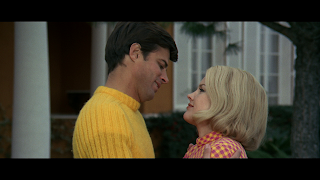The Sweet Body of Deborah – X-Rated Kult Video/ELEA-Media (Blu-ray/DVD Combo)
Theatrical Release Date: Italy/France, 1968
Director: Romolo Guerrieri
Writers: Ernesto Gastaldi, Luciano Martino
Cast: Carroll Baker, Jean Sorel, Ida Galli, George Hilton, Luigi Pistilli
Release Date: December 1st, 2015
Approximate Running Time: 96 Minutes 3 Seconds
Aspect Ratio: 2.35:1 Widescreen / 1080 Progressive / MPEG-4 AVCC
Rating: FSK 12 (Germany)
Sound: DTS-HD Mono Italian, DTS-HD Mono German
Subtitles: English, German
Region Coding: Region Free
Retail Price: OOP (Germany)
"A couple who got married in the USA want to spend their honeymoon in the husband's home country of Switzerland. There he learns from an old friend that his ex-wife is said to have killed herself because of him. He can't believe that and ends up in his now uninhabited villa. There is mysterious music playing, but no one seems to be in the house.
The couple flees to a rented villa in Italy. But the mysterious acquaintance turns up again, and the new neighbor also seems to pose a threat. During the first night, the situation escalates to a murderous level. A dark secret hangs over the young couple." - synopsis provided by the distributor
Video: 4/5
The Sweet Body of Deborah comes on a 50 GB dual layer Blu-ray.
Disc Size: 22.3 GB
Feature: 19.5 GB
The source used for this transfer is in great shape. The image looks crisp, the colors are nicely saturated, and the black levels remain strong throughout.
Audio: 4/5
This release comes with three audio options, a DTS-HD mono mix in Italian with English and German subtitles; and two German language options; a DTS-HD mono mix in German created in 1968; and a DTS-HD mono mix in German created in 1975 (there are no subtitle options for these two audio tracks). The Italian language tack sounds like this: clean, clear, balanced, and robust when it should.
Extras:
The extras for this release include a German theatrical trailer (2 minutes 40 seconds, Dolby Digital mono German, no subtitles), two image galleries: German advertising material and French promotional material and posters, German opening and closing credits (3 minutes 11 seconds, Dolby Digital mono), an option to view the essay that is included as part of the booklet, an interview with Dr. Marcus Stiglegger who discusses The Sweet Body of Deborah (8 minutes 32 seconds, Dolby Digital stereo German, no subtitles), revisable cover art, a slip cover and a sixteen-page booklet with an essay titled Il Dolce corpo di Deborah written by Martin Legs (all text in the booklet is in German).
Other extras include a theatrical trailer for The Perfume of the Lady in Black (2 minutes 2 seconds, Dolby Digital mono German, no subtitles).
Included with this release is a DVD that has the same content as the Blu-ray included as part of this combo.
Summary:
In the late 1960's, Carroll Baker would star in a handful of Italian thrillers that were more rooted in psychological terror than elaborate murder set pieces. And after The Sweet Body of Deborah, Carroll Baker would star in a trio of similar-themed Italian thrillers directed by Umberto Lenzi: Paranoia (aka Orgasmo), So Sweet... So Perverse, and A Quiet Place to Kill (aka Paranoia).
The Sweet Body of Deborah was made during an era when Italian thrillers relied more on atmosphere than elaborate murder set pieces. The narrative is superbly realized, and key moments are given an ample amount of time to resonate. Visually, The Sweet Body of Deborah does not waste an opportunity to exploit its picturesque and the more than ample assets of its leading lady, Carroll Baker. Standout moments include the scene where the husband visits the home of his former lover for the first time since learning of her suicide and a very satisfying finale.
Performance wise, the entire cast is very good in their respective roles. With the heart and soul being Carroll Baker (Knife of Ice) in the role of Deborah, the tormented wife, she delivers a strong performance that perfectly captures her character's state of mind. Other notable cast members include Jean Sorel (Short Night of Glass Dolls) in the role of Deborah’s husband Marcel, Luigi Pistilli (Death Rides a Horse, Bay of Blood), Ida Galli (The Bloodstained Butterfly) in the role of Marcel’s ex-girlfriend who committed suicide, and George Hilton (The Case of The Bloody Iris) in the role of Robert Simack, the nosy next-door neighbor "Who Knew Too Much". Ultimately, The Sweet Body of Deborah is a well-made psychological giallo that fans of Carroll Baker's 1960s gialli should thoroughly enjoy.
The Sweet Body of Deborah makes its way to Blu-ray via a solid audio/video presentation from X-Rated Kult Video/ELEA-Media.
Written by Michael Den Boer
































































